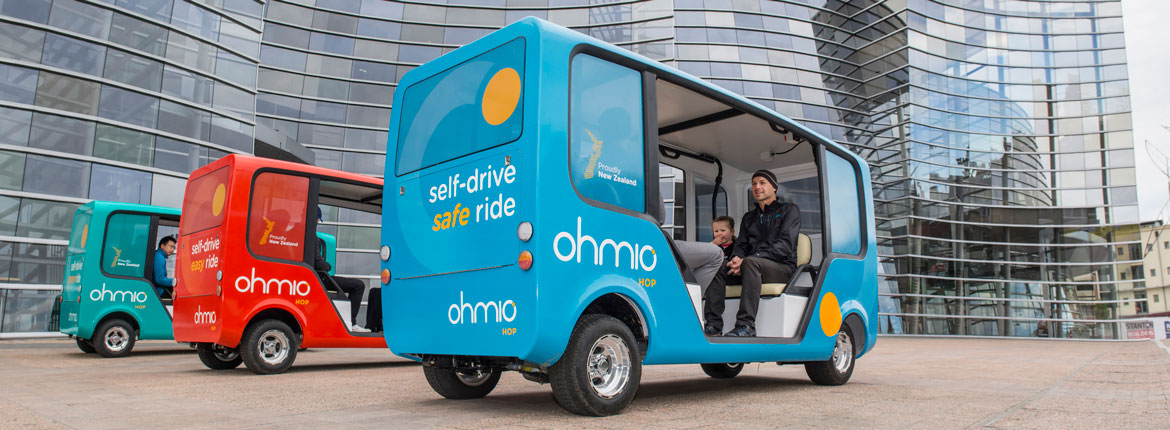Over the last decade, the world’s biggest automotive and technology companies have poured massive resources into developing autonomous vehicle technology. The goal: to unlock a mobility market that, once it evolves, could be worth trillions of dollars.
Jostling alongside global giants is a local transport technology company.
Auckland-based HMI Technologies, through its subsidiary Ohmio Automotion, has this year begun production on a 20-passenger shuttle. The Ohmio LIFT is designed for use in private road environments initially, like airports, shopping centres and retirement villages.
What makes a company from New Zealand with just 60 employees think it can foot it in this market?
HMI Chairman, Mohammed Hikmet, says the company has provided global infrastructure and innovation in transport technology for two decades.
“We knew autonomous vehicles were coming; we knew how disruptive they would be, so we knew this was something we had to be involved in.”
Mohammed says car manufacturers and technology companies are looking to develop fully autonomous vehicles (that can drive by themselves anywhere and in any conditions) to replace the consumer car. But the technology is still well behind, he says.
“We’re targeting a simpler opportunity – customised autonomous vehicles that run on fixed routes. This is technically feasible now.”
Transporting passengers to and from home and the bus or train station is a focus. Mohammed says it will make public transport a more appealing alternative and get traffic moving in congested cities like Auckland.
Flexible design is what makes the Ohmio LIFT unique, giving it an edge over competitors.
The motor and navigating system is kept in the base of the vehicle, so the top shell can be configured to suit different needs. Most of the time the Ohmio LIFT will shuttle people, but it could just as easily function as a street cleaner or container carrier. It can easily be scaled up to carry 80 passengers, allowing it to function like light rail, at a fraction of the cost.
So when and where can we expect to see the Ohmio LIFT on roads?
The first deployment will be at Christchurch Airport, with delivery of a vehicle expected later this year. Meanwhile, an initial agreement has been signed to provide a smart city project in South Korea with 150 vehicles.
“Within three years, we see ourselves starting to replace some public transport routes in New Zealand cities and around the world,” Mohammed says.
This is a race worth watching.
The AA’s Transport Technology Group has been formed to help the AA and its Members understand where technological change is taking the transport system. Here’s how the group sees the future of driverless cars.
Semi-autonomous features that are now available on late-model cars – think adaptive cruise control, lane departure warning systems and parking assist (see p.48) – will become more commonplace in the
New Zealand fleet within the next decade.
We can expect to see autonomous vehicles used regularly on private roads, transporting people around malls and university campuses. Shifting cargo at ports, on farms and at mining and forestry sites will also be done autonomously.
The public transport system will likely experiment with automation – picture a driverless bus carrying passengers down Auckland’s Northern Busway – and autonomous shuttles navigating quiet suburban streets to connect commuters with public transport hubs.
Looking out further, by the 2030s, an increasing number of cars will be equipped with automated features that will allow drivers to take their hands and feet off the controls in certain traffic environments.
As this number grows, we can expect urban roads to be carefully opened up to automated driving.
In designated parts of the network, like sections of the motorway, drivers will be allowed to switch their cars to autonomous mode.
There’s likely to be a small dip in private car ownership, as driverless technology makes ride-sharing a more affordable alternative. But most people will hold onto their cars, even if the focus is on recreational use and less on daily commuting.
From here, the crystal ball gets murky. There are still big question marks around key areas of technology, in particular the ability for cars to ‘talk’ to each other. The ability for robot drivers to handle ambiguity and the legal framework around it, is also unclear. And how much change does society even want? We may find that semi-autonomous cars meet the needs of most drivers perfectly and there’s little demand to take the technology further.
All this makes it impossible to say how much longer it will take to get to a world where, as many predict, autonomous vehicles are deployed en masse, decimating car ownership and enabling big progress on road safety and traffic efficiency benefits. Will we ever get there?
Reported by Barney Irvine for our AA Directions Summer 2018 issue




